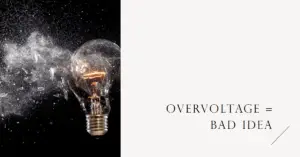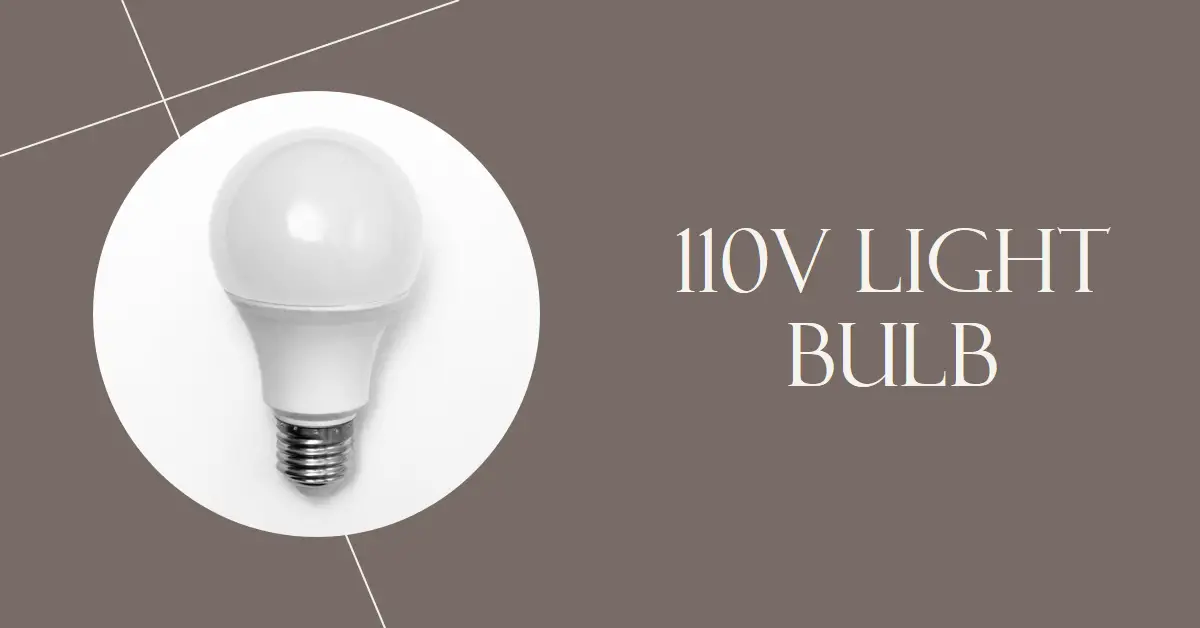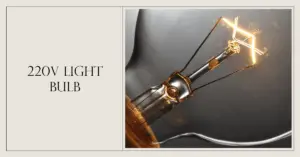Voltage differences can be confusing, especially when it comes to using electrical devices like light bulbs in different countries.
In the USA, the standard voltage for household electrical systems is 110V. However, in many other countries, such as those in Europe and parts of Asia, the standard voltage is 220V.
This raises the question: Can you use a 110V light bulb in a 220V socket? Let’s delve into this topic and find out.
As a short answer, No, you should not use a 110V light bulb in a 220V socket. The voltage rating of a light bulb is crucial for its safe and efficient operation. When a 110V light bulb is used in a 220V socket, it can lead to potential risks and hazards.
Let’s break this down!
Understanding Voltage and Light Bulbs
What is Voltage?
Voltage refers to the electrical potential difference between two points in an electrical circuit. In simple terms, it measures the force that pushes electric current through wires and devices.
Different Voltage Standards Worldwide
Countries around the world have adopted varying voltage standards for their electrical systems. The USA uses 110V, while many others use 220V. Some countries even have multiple voltage standards within their borders.
Common Voltage Ratings for Light Bulbs
Light bulbs are designed to operate efficiently at specific voltages. In the USA, most light bulbs are rated for 110V, whereas in countries with a 220V standard, light bulbs are rated accordingly.
110V vs. 220V: What’s the Difference?
Voltage in the USA (110V) The USA’s electrical system operates at 110V, which means that the electrical devices and appliances sold in the country are designed to work with this voltage. This includes standard 110V light bulbs.
Voltage in Other Countries (220V and Beyond) Many countries worldwide use 220V as their standard voltage. This means that using a 110V light bulb in a 220V socket can lead to potential risks and complications.
Traveling and Voltage Considerations For travelers, it’s essential to be aware of voltage differences when using electronic devices and appliances abroad. Not all devices are designed to handle different voltages, so caution is necessary.
Read also my article: Using Your 110V Hair Dryer on 220V Outlets!
Can I Use a 110V Light Bulb in a 220V Socket?

Potential Risks and Hazards Using a 110V light bulb in a 220V socket can pose serious risks, such as overheating, short-circuiting, or even causing fires. The higher voltage can overload the light bulb, leading to its premature failure.
Impact on Light Bulb Performance Even if a 110V light bulb manages to function in a 220V socket temporarily, its performance will likely be compromised. It may produce less light or have a significantly shorter lifespan.
Compatibility Issues Besides the voltage difference, the physical design of light bulbs and sockets can also vary between countries, leading to compatibility issues when attempting to use a light bulb designed for one voltage in a socket intended for another.
Daul Volage 110v/220v Light Bulbs
If the bulb is labeled as “110/220V,” it means that it is designed to be compatible with both 110V and 220V electrical systems. In this case, you can safely use the bulb on a 220V socket without any issues.
The bulb’s dual voltage feature allows it to adapt to higher voltage without causing damage or compromising its performance.
When using a “110/220V” bulb in a 220V socket, you’ll enjoy the same level of brightness and longevity as you would when using it on a 110V system.
This type of bulb is particularly useful for international travelers or individuals with devices that may require voltage flexibility. Always check the label or packaging of the bulb to ensure its compatibility with the voltage of the electrical system you intend to use it with.
Understanding Light Bulb Specifications
Wattage, Voltage, and Amperage:
Understanding the relationship between wattage, voltage, and amperage is crucial for selecting the right light bulb for your needs and ensuring its safe operation.
Types of Light Bulbs (Incandescent, LED, CFL, etc.):
Different types of light bulbs have varying voltage and wattage requirements. LED bulbs, for instance, are generally more voltage-flexible compared to traditional incandescent bulbs.
Reading Light Bulb Labels and Packaging:
Reading the information on light bulb labels and packaging can help you identify the voltage and wattage specifications, ensuring you choose the appropriate bulb for your intended use.
Options for Using 110V Light Bulbs in 220V Countries
Using a Step-Down Transformer:
A step-down transformer is a device that can convert 220V to 110V, allowing you to use 110V light bulbs in countries with a 220V standard. However, it’s crucial to choose the right transformer to avoid any safety issues.
Voltage Converters and Adapters:
Voltage converters can also be used to adjust the voltage to match the requirements of the light bulb. Adapters may also be necessary to fit the different types of sockets.
Choosing the Right Solution for Your Needs:
Consider the duration of your stay, the number of devices you plan to use, and the convenience and safety of each option when selecting the right solution.
Safety Precautions and Recommendations
Electrical Safety Concerns
Safety should always be a top priority when dealing with electrical devices. Avoid using mismatched light bulbs and ensure all connections are secure and insulated.
Proper Usage of Voltage Converters
If you decide to use a voltage converter, follow the manufacturer’s instructions carefully to prevent damage to your devices and ensure your safety.
Consulting a Professional Electrician
When in doubt or facing complex electrical situations, it’s best to consult a licensed electrician who can offer expert advice and solutions.
Read also my article: Connected 220v Hair Dryer to 110v Outlet? Here’s What Will Happen!
Buying Light Bulbs for International Use
Dual Voltage Light Bulbs
Dual voltage light bulbs are specifically designed to work with both 110V and 220V systems, making them a convenient choice for travelers.
Universal Compatibility Light Bulbs
Some light bulbs are designed to be universally compatible with various voltage standards, eliminating the need for additional converters or transformers.
Shopping Tips for Travelers
Check for universal compatibility or dual voltage features when buying light bulbs for international use. Opt for reliable brands and quality products to ensure safety and performance.
Conclusion
Using a 110V light bulb in a 220V socket is not recommended due to potential safety hazards and performance issues.
Understanding light bulb specifications and voltage differences can help you make informed decisions and choose the right lighting solutions, whether at home or abroad.
Prioritize safety, and when traveling internationally, consider investing in dual voltage or universal compatibility light bulbs for a hassle-free experience. Always remember to seek professional advice when dealing with complex electrical situations.
Want to learn more about electricity? Check my YouTube channel!
Are You An Electrical Engineer or Electrician?
Install my Free On Google Play Now! It’s 100% Free
The staff I recommend (Amazon Affiliate Links to products I believe are high quality):
- Economy 120 Volt/60Hz AC Power Source – Step-Down Voltage & Frequency Converters 1800W
- UNI-T Digital Multimeter Tester UT139C
- 50-Amp Extension Cord for RV “100ft”
- Voltage Stabilizer 110/220v
- Hair Dryer “best selling“
- TOSHIBA EM131A5C-BS Countertop Microwave Ovens
Disclaimer: This contains affiliate links to Amazon products. I may earn a commission for purchases made through these links.



